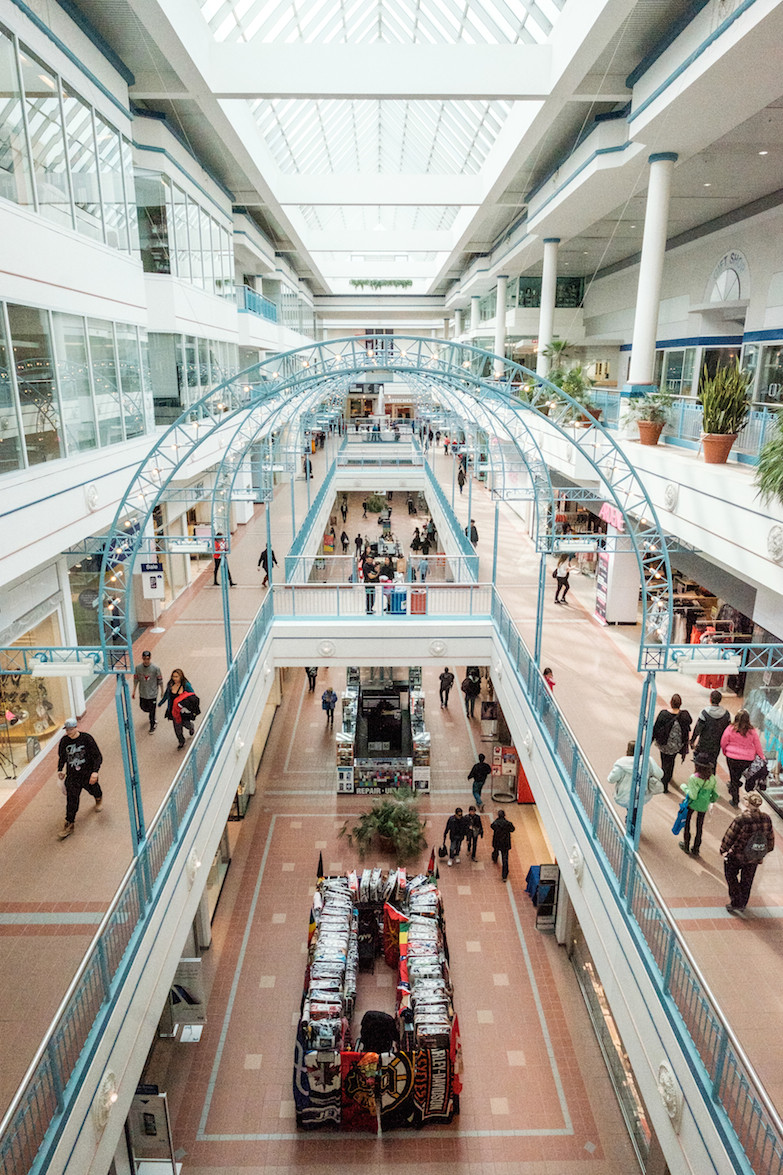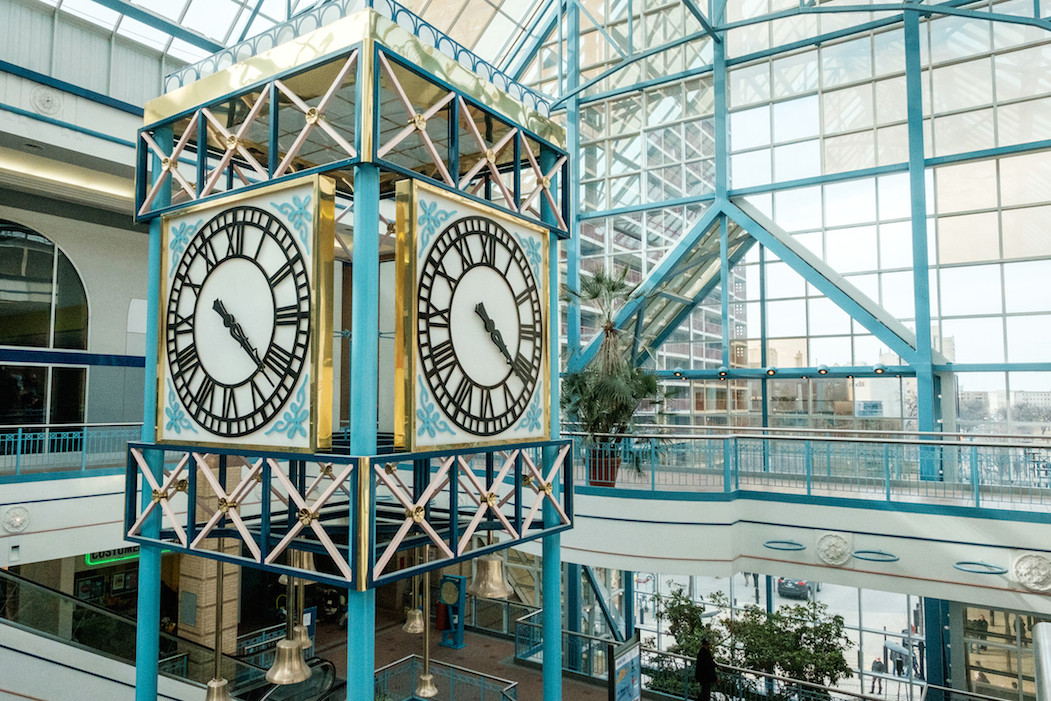Meet me at Portage Place
Imagining possible futures for our downtown mall
Portage Place Shopping Centre’s tagline is “Meet here, Shop here,” but balancing the role of meeting space for the community with the logistics that retail demands has many challenges.
As a meeting place, historically, it hasn’t been open to all; many communities have observed that mall policies seem to be enforced selectively. However, the management’s recent willingness to reconsider their policies have many in the community hopeful for a new approach towards members of the public who visit Portage Place.
“In the downtown there is a lack of gathering places that feel like they are safe for the general community,” Michael Champagne, founder of Aboriginal Youth Opportunities and community activist, says. “Due to the lack of gathering places that are safe, places such as Portage Place become de facto community town halls.”
This February, Indigenous elder and war vet Joseph Meconse was asked to leave the mall’s food court after spending 30 minutes there, the limit according to mall policy at the time. The community responded by holding a round dance in the food court.
In mid-March, Portage Place announced that they would be complementing their security forces with Bear Paw security, and named Joseph Meconse as Ogichidaa, a ceremonial Ojibwe title meaning “warrior,” for the mall. They’ve revoked the 30-minute rule for loitering in the food court, and will be adding two Indigenous guards from Bear Paw to their security team.
Could this mark a turning point for Portage Place, and is it possible to have a retail centre that also functions as a safe, accessible meeting place in downtown Winnipeg?

Some strategies could easily bridge the mall’s dual functions as meeting place and retail centre.
“It would be cool to have more Indigenous stores in there,” Monkman says. “There’s a lot of Indigenous fashion designers that are coming up, and there’s a lot of appetite for people to want to buy that stuff. I think that if you were to have stores like that located inside of Portage Place, I think that would drive up more business inside there.”
Portage Place manager David Stone notes that there is not a lot of retail space left in the mall, and that it’s not an easy space to manage.
“Our biggest and most difficult challenge is managing the many social issues we face regularly such as substance abuse, intoxicated persons, retail theft and other issues that stem from poverty and a lack of support,” Stone says.
“The result of social issues and poverty issues have a strong effect on retailers through lower margins (profits) and increased theft (loss). Until the social issues are dealt with retail will always be a challenge.”
Champagne cites Neechi Commons as a successful example of a business that welcomes those who may be living in poverty, or have less access to disposable income.
“It’s been very welcoming to community members, and what it does is it makes those community members much more likely to spend those few dollars that they do attain within that establishment. So it’s more of a long-term strategy than a short-term one,” Champagne says.
Over the last decade, Gina Sylvestre – assistant professor in the department of geography – has been working downtown and frequenting Portage Place. She’s noticed a definite improvement in terms of safety in the area.
The location of the mall and proximity to bus routes contribute to the mall’s position as a social hub, Sylvestre says.
“I get off the bus and I walk through that door and I interact with people as I walk through there, but I’m observing as a geographer what’s going on in the food court, and it is a natural place to meet,” Sylvestre says.
Sylvestre’s research focuses on aging populations, and so she also considers the impact of seating on a space’s accessibility.
“In a mall, there’s more than seniors that are walking... and they need more places to sit, they need to be accommodated and open and welcoming,” she says.
In 2013, the downtown retail centre made the news after Annie Henry, an Indigenous elder, and Julie Dyck were both removed from the mall by security after sitting on the marble planters. Both Henry and Dyck had medical conditions that necessitated rest.
While it might make the space more accessible for elders or those with medical conditions, adding seating is not currently a priority for Portage Place.
“We do not look to add seating,” Stone says. “We have benches located conveniently in our centre and have recently added signage to direct people to ensure the available seating is priority for seniors and persons with disabilities.”
In the mall’s main centre court, just off Edmonton Street, there is one bench tucked along the edge of each escalator – these two benches are marked with the signs Stone describes. The much smaller court at Kennedy Street also contains two benches, but in the main corridor linking the two, seating is notably absent.
“If we look at age-friendly ethos and that kind of thing, what seniors say is there’s not enough benches. They’d like to walk places, but they need to stop and rest,” Sylvestre says.
She also notes that if Portage Place developed its space to be more of a meeting place, that could help foster intergenerational interaction between seniors and youth, another demographic that hasn’t felt very welcomed in the retail space.
Champagne notes that the inclusion of initiatives like Graffiti Art Programming’s Studio 393 and With Art within Portage Place are evidence of the mall’s willingness to welcome youth into their space.
“Urban Indigenous youth are hungry to find spaces where they feel welcomed,” Champagne says. “If we look at the simple realities about the spaces where people do gather, I feel like there is a great opportunity that is before Portage Place to be a welcoming space for inner-city youth, Indigenous youth, newcomer youth, as well as people living in poverty.”
Could Portage Place embrace these opportunities and leave the controversies of the past behind?
“The challenge for Portage Place for 30 years has been the abundance and high profile of those in the community who are suffering. These people need help and support from social agencies and their community,” Stone says. “Because these are lacking they tend to come to Portage Place to get out of the cold, the heat and perhaps do other things. This is not what any shopping centre was meant to be.”
But that doesn’t mean there isn’t room for Portage Place to become more than a shopping centre.
“It’s just a matter of having an imagination and coming up with a strategy to just embrace the people that are here,” Monkman says.
Stone states that the mall is working with Indigenous groups to help bring services and supports downtown, and they’re also part of a special advisory council formed with the Downtown Winnipeg Business Improvement Zone.
“Portage Place will always be a meeting place for many. We encourage that in many ways,” Stone says.
The inclusion of Meconse, Bear Paw and initiatives like Studio 393 into the culture of Portage Place are a few reasons to be hopeful, according to Michael Champagne. And it could be possible for the mall to hold dual roles as a place to meet and a place to shop – as their tagline suggests.
Published in Volume 70, Number 26 of The Uniter (March 31, 2016)







